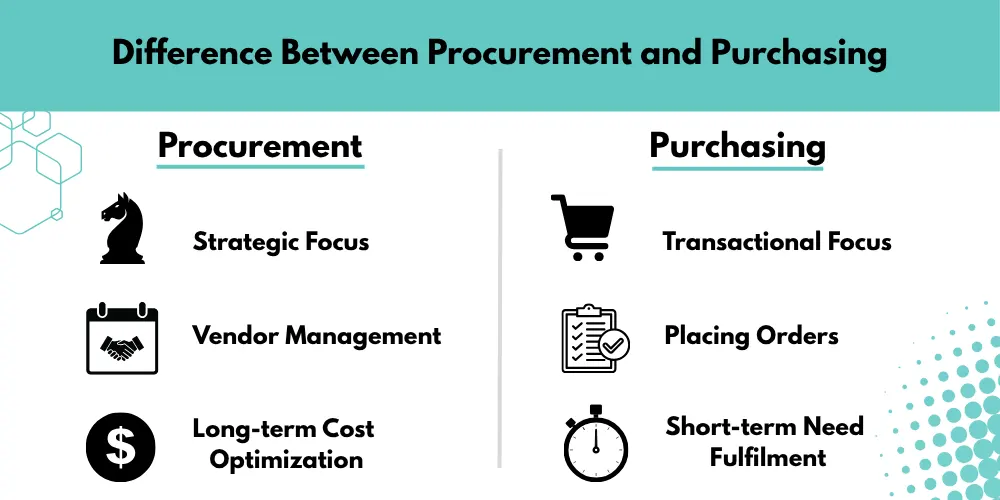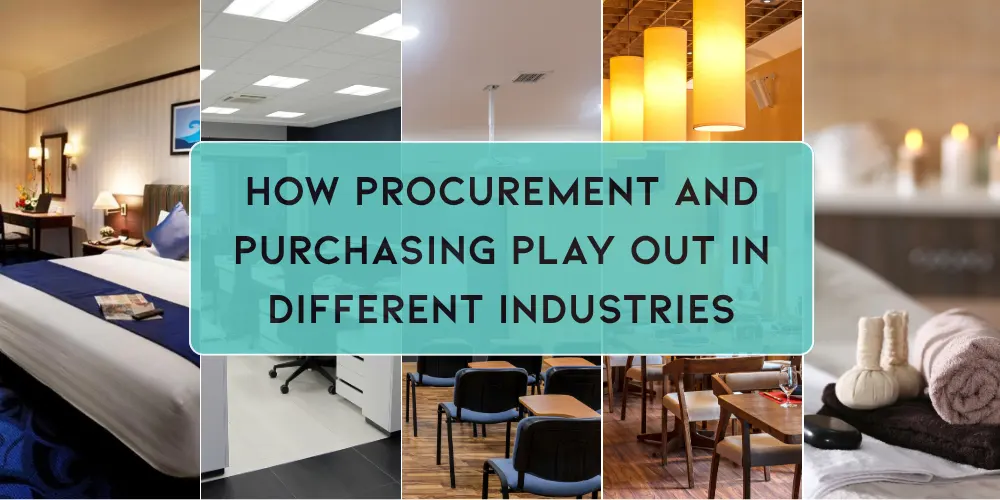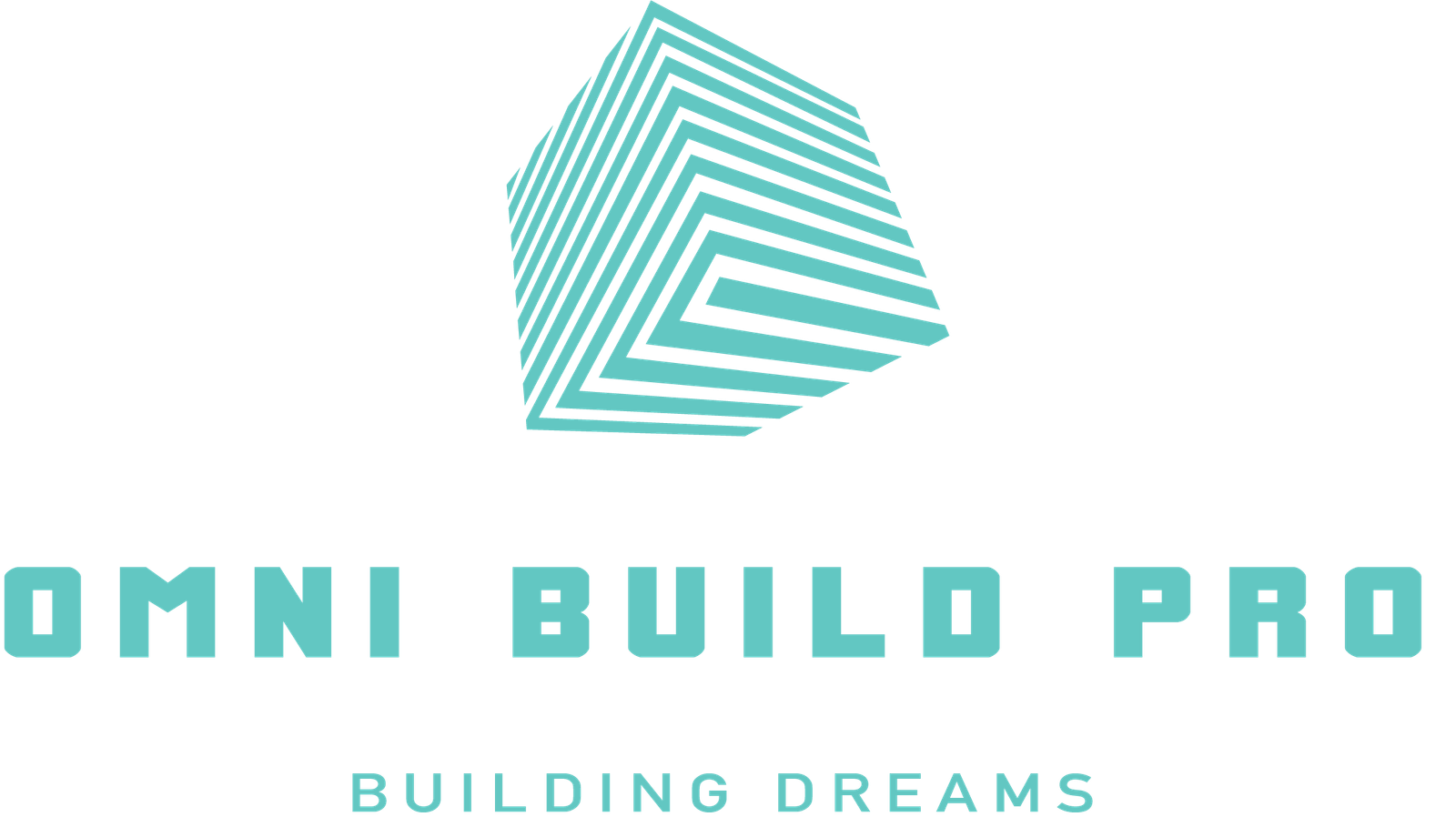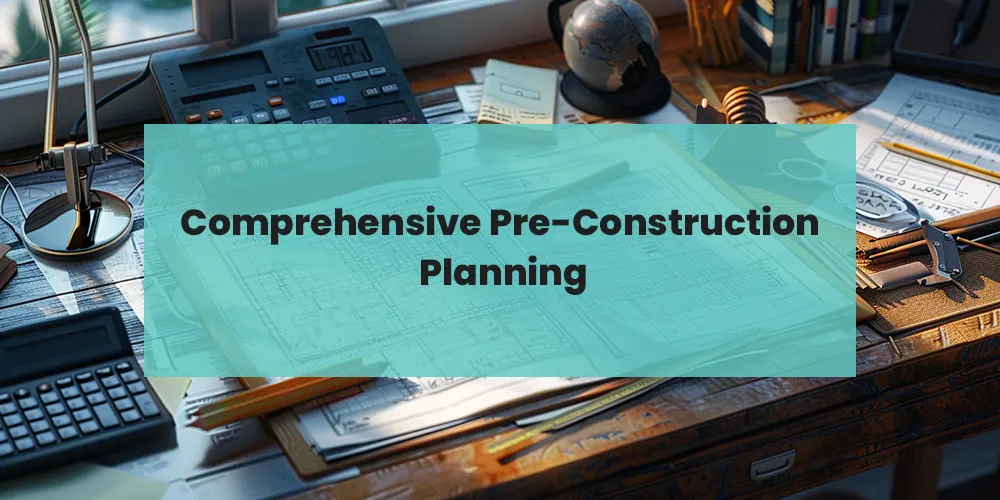You’ve probably seen it happen in meetings that someone gets up and says, “No worries, the procurement team is on it”, and 5 minutes later, they say, “We already finished the purchasing process; we are good”. Or maybe sometimes you experienced that your fellow employee says procurement when they really mean purchasing, and the whole team nods along like they’re the same thing.
Perhaps you’ve done it yourself. Well, you’re not alone!
In many businesses, especially growing ones, procurement vs purchasing gets tossed around interchangeably. To be honest, it occurs with so many people, even with procurement professionals. Well, we can’t blame them. They both sound the same on paper, and both involve getting goods and services. Confusing these two can cause more than just a vocabulary hiccup; it can lead to budget leaks and misaligned strategies.
This blog exists to clear that up! We’re going to break down the difference between purchasing and procurement in real-world terms: no corporate gibberish, no textbook definitions, just a basic explanation.
In this blog, you guys can explore how procurement plays a strategic role, vendor management, and long-term planning. You will also learn about the immediate purchasing process and day-to-day transactions. Furthermore, we will show how the procurement team affects the project far beyond just placing orders.
So, let’s solve this confusion.
What Is Procurement and Purchasing?
Procurement and purchasing both deal with acquiring goods or services, but their scope and purpose are significantly different. Now, let’s learn about them in detail.
✅ What Is Procurement?
Procurement is the strategic process of sourcing, negotiating, contracting, and managing suppliers to acquire goods and services to meet a company’s needs. It is led by Procurement professionals or a Procurement Manager. Procurement is more than purchasing things; it is about developing good relationships with suppliers and focusing on long-term value. Ensure companies do not end up overpaying for goods and services. A typical procurement team might be involved in:
- Vendor selection and evaluation
- Contract negotiation
- Cost and risk mitigation
- Supplier chain management
- Ensuring alignment with business goals
In short, procurement is the brain of the operation, which focuses on the big picture, such as cutting costs, quality, schedules, and mitigation of risks.
🧠 Here is a fun fact: When companies work with Procurement Service Providers, they often approach the entire supply cycle more strategically than those relying on ad hoc purchasing. Surprisingly, even having professionals do the job can stop several budget headaches.
✅ What Is Purchasing?
Purchasing is a subset of procurement. It’s more transactional in nature. In short, it is about the actual buying. But purchase only those goods or services that have been approved or requested based on terms established by procurement. In simple words, after the procurement preparation is completed, through a selection of suppliers and signatures on contracts and terms, the purchase then steps in to effect an actual order. It involves:
- Creating purchase requests
- Placing purchase orders
- Receiving goods
- Processing payments through accounts payable

Why Does the Difference Between Procurement and Purchasing Matter?
The Difference Between Procurement and Buying is to understand that procurement has laid the ground, and purchasing has made the action. They are both very needed, and they have different purposes of keeping your business running without any unpleasant surprises. A business that treats purchasing like procurement may miss out on the following:
- Strategic vendor partnerships
- Opportunities for cost savings
- Long-term supply chain efficiencies
Meanwhile, a business that invests in a proper procurement strategy gains a competitive edge, especially in industries where timing, quality, and vendor trust are everything.
Procurement vs Purchasing: Side-by-Side Comparison Table
At this point, you may find yourself thinking, “Okay, I understand the general aspects, but can someone just give me a clear overview so that I do not confuse the two in my next meeting?”
Well, leave it to us!
To make it easier to find the Difference Between Procurement and Purchasing, here is a simple comparison to get your story straight so you can sound like a pro and maybe save your procurement manager that facepalm moment. 😁
|
Aspect |
Procurement |
Purchasing |
| Scope | Strategic: Sourcing, negotiation, vendor management, compliance, risk handling | Operational: Ordering, receiving, and paying for goods/services |
| Objective | Long-term value creation | Fulfilling immediate needs |
| Metrics | Cost avoidance, supplier performance, risk reduction, bottom line impact | Order accuracy, delivery time, price per unit |
| Led by | Procurement manager/team | Purchasing officer/clerical staff |
| Key Functions | Vendor evaluation, procurement manager oversight, budgeting, forecasting | Raising purchase orders, tracking inventory, receiving invoices |
| Process Includes | RFPs, RFQs, supplier audits, contracts | POs, delivery tracking, payment |
| Tools Used | Spend analytics, supplier portals, ERP | Purchase order software |
| Risk Management | High priority | Minimal |
| Time Horizon | Long-term: Focused on building value over time | Short-term: Immediate need fulfillment |
| Value Delivered | Business growth, supply chain resilience, strategic partnerships | Inventory fulfillment, cost tracking, transaction documentation |
So now, we can say procurement is not a synonym for purchase. It’s a rookie mistake, and considering them the same will cost your company too much money. Thanks to this little comparison now, you have it in your back pocket. Because of it, you know the difference, and you know how these processes work together. 😉
📊 Did you know?
According to the Hackett Group, Companies that align procurement with business strategy see 133% greater annual savings than those that don’t.
Procurement is a value driver, while purchasing is a process executor. Both are important, but treating them as equal can lead to wasted opportunities, especially in complex industries. For instance, a FF&E and OS&E Procurement Manager at Omni Build Pro won’t just place orders; they forecast needs, analyze vendors, and make sure purchasing activities align with long-term goals. That’s the difference between saving money once and saving money every year.
The Long-Term Value of Procurement Over Purchasing
Now this is where things become interesting; procurement is not only about finding the lowest price tag. Too often, procurement is misunderstood as just another way to “get the lowest price”. However, the innovative organizations in the real world realise that procurement is a long-term game. This game could increase the bottom line, alleviate the number of headaches in the business, and make a measurable contribution to the industry.
🧠 Total Cost of Ownership vs. Just the Price Tag
So what is the distinction between Total Cost of Ownership (TCO) and Price?
Let’s say you’re sourcing equipment for a new hospitality venue. A purchasing mindset might go for the cheapest vendor. But the procurement mindset considers risk mitigation, vendor reliability, service support, delivery timelines, and long-term asset value.
Did you get my point of view? Well, I bet you didn’t! 😂
Let me explain it again, this time in detail and simpler words. I hope I’m able to get my point across to you with this now. Here it is:
Imagine that you purchase office chairs at half the price of the alternative. Win, right?
But six months later, the wheels fall off, the back pain complaints of your team increase beyond all proportions, and you have to replace every chair. Now, something that seemed so cheap looks expensive.
Procurement specialists are not concerned only with the price of the product, but instead care about Total Cost of Ownership (TCO). In simple words, they calculate the quality of the product, its durability, its maintenance, the reliability of the supplier, and even the cost of disposal.
The role of Procurement in Real Business Value
When well worked, procurement does much more than place orders. It fuels:
- Cost reduction: Sustainable rather than short-term.
- Risk mitigation: Vetting, ensuring compliance, and preventing supply chain disruption.
- Higher ROI: The quality services and materials result in fewer reworks, customer satisfaction, and better profit generation.
📈 Strategic Procurement Drives ROI
Procurement is tied to real business outcomes, not just inventory. It improves:
- ROI through better contract terms and bundled supplier deals.
- Compliance through procurement policy alignment.
- Quality is achieved by selecting vetted suppliers with proven results.
- Accounts payable efficiency through streamlined invoicing and vendor management.
According to Deloitte, high-performing procurement organizations reduce total procurement costs by up to 15% and see a 30%+ improvement in compliance, proving that the real ROI of procurement goes far beyond upfront pricing. In industries like hospitality, Hotel FF&E Procurement demonstrates the strategic power of procurement. These involve logistics, brand consistency, and lifecycle value. It’s not just about buying furniture or fixtures. It’s about coordinating delivery schedules, confirming long-term durability, and keeping the guest experience consistent across locations.
Bottom line? Purchasing keeps the wheels turned now, but procurement makes sure that the wheels are not falling off tomorrow.

How Procurement Differs from Purchasing in Practice?
While the terms procurement and purchasing often get used interchangeably, their application in real industries tells a different story. We did the theory, now let us do the nitty-gritty. However, spreadsheets and definitions are really terrific, but there is nothing more illuminating about the procurement focuses vs. purchasing debate than witnessing how they play out in various industries. Here are some everyday situations where product or service choices can make or break a project, unless you follow a proper procurement route or settle for basic purchasing decisions.
🏨 Hotels
Imagine furnishing a new hotel. Purchasing might involve ordering chairs and beds, but procurement goes several levels deeper. Procurement officers will plan the design, aligning with brand standards. They manage lead times, ensuring vendor compliance, and coordinating phased deliveries with construction schedules.
Here’s a fun fact: According to PWC, procurement reduces project delays by up to 35% and budget overruns by 22% in the hospitality and healthcare sectors, proving that it’s not just about buying, but building outcomes.
That’s why Hotel FF&E Procurement isn’t just about picking products, it’s about balancing design integrity, logistics, and lifecycle value across the project. They make sure the Hotel is completed on time, on budget, and with a wow factor.
🏢 Office Projects
Consider outfitting a new corporate headquarters. You can go through the Internet, order several chairs, and be considered to have technically completed the task. The Purchasing Process might stop at selecting desks and ordering supplies.
But procurement professionals consider floorplan efficiency, space usage, ergonomic compliance, and vendor performance, all while managing installation logistics. They understand that an effectively designed office environment involves not only layout but also the design that satisfies health and safety codes.
Rather than that, they also maintain relationships with the suppliers, make purchase orders, and make sure everything works together, as part of a well-planned system. The result? Procurement of Office Supplies will enable businesses to save money and reduce the stress of executing the task at the last minute.
🏫 Schools
School facilities demand more than buying furniture. Purchasing supplies is not all about the price; it is all about quality assurance, safety, and long-lasting durability. These things can only be achieved through strategic procurement. A Professional Procurement team can thoroughly select suppliers to buy goods and services. They make sure that the durability of Equipment Procurement for Schools will be long-term, and that it meets safety standards related to children. So the classrooms will not only be functional, but they will also have built-in sustainability. Whether it’s desks, smartboards, or lab equipment, supply chain management plays a central role.
🍽️ Restaurants
Outfitting a restaurant goes beyond ordering tables and kitchenware. It’s about sourcing raw materials and FF&E with long-term cost savings, supplier reliability, and design consistency. Strategic purchasing processes help prevent costly retrofits or compliance issues down the line. Successful restaurants are well-prepared in terms of procurement planning to ensure good quality, comply with health standards, and achieve long-term cost savings.
Simple buying procedure? It provides you with today’s ingredients. Strategic Restaurant Procurement? It fixes the relationships with suppliers, good-quality equipment, and stable & reliable work.
💆♀️ Spas
The spa experience is all about luxury and exclusivity. They have unique sourcing needs, from premium fittings to ambiance-focused design elements. Behind that peaceful vibe is a procurement manager who helps identify vendors that balance aesthetic, quality, and client experience. They choose strategic sourcing, and make sure that all products, including massage beds and essential oils, meet luxury standards. With the aid of Spa Procurement Solutions, a business can procure high-quality products. That enhances the experiences of a client as well as safeguards the reputation of the brand.
✅ The message is therefore as clear as it is simple: smart procurement planning saves time, money, and stress, whether in a hotel, school, spa, or an office in a skyscraper.
Choosing the Right Approach Based on Your Business
At this point, you are likely to notice that the procurement team and purchasing team are not at daggers points; they are simply operating on different planes of the same mission. Not every situation calls for full-scale procurement. Sometimes, simple purchasing is a quick, transactional decision to get things done. But when your business involves long-term scaling, compliance, or complex vendor networks, procurement becomes essential.
The key question is at what point businesses know to stick with simple purchasing and when it’s time to move toward a more strategic procurement approach.
Let’s simplify it with a couple of real-life examples:
When to Rely on Purchasing:
- A startup needs to order a few laptops and desks to get started.
- A single café reorders ingredients from its usual supplier.
- A pop-up store buys low-cost displays for a one-time event.
These cases favor speed and simplicity, core strengths of purchasing activities. When speed alone is what you want, then buying comes to the rescue and does the job quickly, easily, and transactionally.
When Procurement is the Smarter Option:
- A hotel chain is rolling out a new interior design standard across all properties.
- A franchise is planning bulk equipment purchases across 30+ outlets.
- A construction firm is managing vendor risk across a multi-year project.
- A healthcare system needs a consistent, safe, and cost-effective supply sourcing.
In these scenarios, a procurement team aligns spend with business goals, manages timelines, enforces compliance, and ensures vendor accountability through well-designed supply chain management systems. That’s why, according to Klynveld Peat Marwick Goerdeler (KPMG), 64% of CEOs now see procurement as a strategic business enabler, not just a cost-control function.
At Omni Build Pro, we understand that it is not a Procurement vs Purchasing debate, but rather an understanding of when to use each method. Our procurement professionals don’t just process orders. We assist companies in transcending the simple process of purchasing to deliver strategic procurement services. Our team builds scalable procurement strategies that support growth, improve margins, and reduce risks. We all know procurement is not only about buying, but about being smarter, faster, and ahead of the field.
Conclusion – Procurement Drives the Bigger Picture
In the end, the real difference isn’t just between procurement and purchasing, it’s about seeing how both play their part in your business strategy. While purchasing meets immediate, transactional needs, procurement professionals operate on a strategic level, building supplier relationships, planning for long-term growth, and mitigating operational risks. It’s not really Procurement vs Purchasing. It’s Procurement and Purchasing working in synergy to support your business goals and safeguard the bottom line.
The key lies in knowing when a quick purchase will suffice and when your business needs a more thoughtful, future-focused procurement approach. Whether you’re managing a startup, a hospitality venture, or a global supply chain, the difference can be transformative.
And when you’re ready to see the bigger picture? That’s where Omni Build Pro steps in. We’re not just service providers!
We’re strategic enablers helping you align procurement with growth, efficiency, and long-term success. At the end of the day, smart buying is not all you need, but strong businesses.
🧠 Frequently Asked Questions
What are Procurement Services?
Procurement services are described as skilled services employed by businesses to deal with the whole process of procurement, including risk identification to steer clear of suppliers, procurement, and risk mitigation.
Omni Build Pro offers a brilliant set of solutions to help businesses plan strategically, select vendors, and facilitate easy purchasing activities. It is not so much the story of buying, but also the story of constructing smart, booster, and resilient supply chains.
Is Procurement the Same as Purchasing?
They are related, but NO, procurement and purchasing are not the same.
Purchasing is a simple transactional activity: placing an order and receiving goods. However, procurement is a broader scenario that involves planning, supplier evaluation, contract negotiation, and cost optimization to ensure long-term business value.
For Example:
- Person 1 is going for lunch; he bought a meal and ate.
- Person 2 is going for groceries and plans a week’s worth of meals.
Their goals are the same, both relate to food, but only Person 2 supports sustainability and foresight.
What does Procurement Department do?
A procurement department deals with all the activities that occur before, around, and after the purchase of any objects. Their responsibilities include:
- Reviewing purchase requests
- Evaluating and selecting vendors
- Managing contracts and accounts payable
- Monitoring supplier performance
- Aligning sourcing strategies with business goals
They not only put purchase requests in place but also develop purchasing strategies, review vendors, support negotiations of contracts, and make sure the overall process is aligned with the company’s objectives. They liaise closely with procurement officers, the legal department, and accounts payable departments to ensure the business receives the correct products at the correct cost, without incurring risks, and without any hitches.



